
Story by Miriam Raftery
Photo, left: "Would you want these kids breathing that, every day for 15 years?" -- Jessica Webb
June 5, 2015 (Lakeside) – Imagine up to 250 trucks a day – one every minute and a half—hauling sand along a rural road right in front of your house--five days a week for the next 15 years or more in El Monte Valley, if a sand mining developer has his way. It gets worse: noise and dust from sand mining operations clogging the area, kicking up potentially deadly Valley Fever spores lurking in soil here, where several El Monte Valley residents have already contracted the disease.
The sand loads would be transported for use on highways, roadways and other aggregate projects across San Diego County—potentially bringing sand laden with Valley Fever spores to construction projects near you. All thanks to a deal cut by Helix Water District to settle litigation over a golf course and water reclamation deal gone sour on land that Helix owned in El Monte Valley, a county-designated scenic view corridor.
This project has the Orwellian-like name “El Monte Nature Preserve” though all parties including the developer concede it is first and foremost a mining operation that will strip bare the valley for decades, lowering the valley floor 30 feet with dredging far deeper in places, in a project three times wider than Lake Jennings.
Lakeside residents and community planners reacted with anger and horror as county officials and representatives of the project developers laid out their plans to alter a major use permit issued for a golf course to instead allow mining. The project’s proponents fielded heated questions from a crowd of over 140 residents—all of them opposed to what one called a “destruction projection.”
Map (right): Project site, in blue and yellow, dwarfs Lake Jennings below.
The Valley is home to over 25 equestrian trails and 100 equine-related businesses. Owners worry about loss of recreation, horse trails and revenues. It’s one of the most beautiful places in all of East County – a place where many have lived a lifetime and others have come recently—including new residents who moved here in January and were never told that the Valley may soon become a living hell, changing life here forever.
Enviro Mine Inc. is p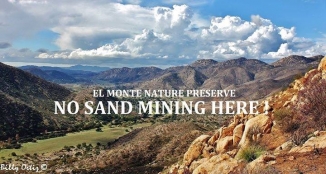 roposing a 565-acre project including 199 acres of sand mining that would dredge the river bed down as far as 90 feet – 60 feet below the water table. That could contaminate well water and force residents to accept piped in city water. The project also calls for mine tailing ponds to dump the slag on both ends of the mining excavation, taking a total of 15 to 18 million tons of sand out in total, or 1.5 million tons a year.
roposing a 565-acre project including 199 acres of sand mining that would dredge the river bed down as far as 90 feet – 60 feet below the water table. That could contaminate well water and force residents to accept piped in city water. The project also calls for mine tailing ponds to dump the slag on both ends of the mining excavation, taking a total of 15 to 18 million tons of sand out in total, or 1.5 million tons a year.
Photo, left: El Monte Valley as it currently appears, courtesy of "El Monte Nature Preserve" on Facebook, a site dedicated to opposing the sand-mining project.
 Warren Coalson from Enviro Mine (photo, right) says about 2 million cubic yards of waste material will be used to backfill the two ponds, which are more like lakes in size.
Warren Coalson from Enviro Mine (photo, right) says about 2 million cubic yards of waste material will be used to backfill the two ponds, which are more like lakes in size.
After 15 years, the developer says they plan to “restore” the site with native vegetation and a 100-acre pond – a far different habitat than what’s there now. Reclamation on up to half the project could begin in 7 or 8 years---That’s if they don’t apply to extend the mining permit, which is common in mining operations, and if the economy remains strong enough to sell sand at the ambitious schedule forecast.
ECM visited Hanson Pond, site of a far smaller ex-sand mining operation in the same valley, which was supposedly restored. We found slick, green slime on the pond and a single duck – far from the flowering meadows and thick vegetation teeming with many sensitive species of birds and animals that currently make El Monte Valley their home. Other areas were terraced but not adequately revegetated, while large tracts remained as stripped, bare earth (photos below by Leon Thompson)


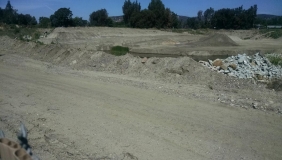

Not present, but a key player is Michael Beck, partner in the El Monte Nature Preserve LLP. Some residents have voiced dismay that Beck, who has previously positioned himself as an enviornmentalist with a local conservation group in the past, would push forward a sand mining project despite the prospect of some riparian habitat restoration decades down the road. Beck is a member of the San Diego County Planning Commission, which would be asked to vote on the project after Lakeside's planning group issues a recommendation to deny or approve the project. Lakeside's planning members took no action at Wednesday night's meeting, but their votes are merely advisory and ultimately, power rests with County Supervisors to determine the project's fate.
Paul Adams with El Monte Nature Preserve LLP promised the developer would install a trail system by completion but said pointedly, “The mining process is going to impact everybody.”
That doesn’t sit well with residents in this rural community, or the planning group members elected to represent them. Here’s a sampling of remarks and pointed questions raised by the planners, before residents aired their views:
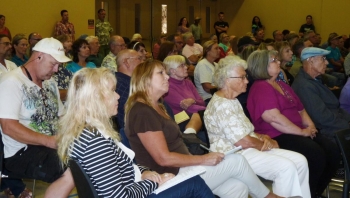 Planning group member Milt Cyphert noted that many residents depend on well water. “What happens to all that water you’re mucking up?” When a spokesman for the developer stated “I don’t believe this will affect wells,” the crowd guffawed.
Planning group member Milt Cyphert noted that many residents depend on well water. “What happens to all that water you’re mucking up?” When a spokesman for the developer stated “I don’t believe this will affect wells,” the crowd guffawed.
Cyphert continued, “ We’ve had Valley Fever, and our animals have had it. How are you gonna mitigate that?” (The crowd applauded this point.) The developer conceded, “The only thing we can do is water the surface to keep the dirt down.”
Residents may have good reason to be skeptical. Watering down dirt didn’t work so well in Ocotillo during construction of a recent wind project, when residents made dozens of complaints about dust and a shortage of water trucks as huge clouds of dust billowed forth from the project, as the photo at right shows. Also some developers mix water with dust suppression chemicals – chemicals that can become flammable when they dry out. In a drought, can the developer really afford or obtain enough water to suppress dust daily for 15 years or more without resorting to chemical dust suppressants?
Paul Sprecco asked if sand would be used locally. The developer confirmed that’s expected, due to the high cost of hauling it far afield.
 Deborah Montgomery noted that Hanson Pond is “green and slimy, full of mud, not pretty. I can’t imagine a bigger sludge pot out there.”
Deborah Montgomery noted that Hanson Pond is “green and slimy, full of mud, not pretty. I can’t imagine a bigger sludge pot out there.”
Allen Wyatt Junior stated bluntly, “This is a mistake in the El Monty Valley,” drawing applause from the crowd. He objected to trucks all day in the valley and clogging local highways, as well as water pollution.
Steve Rebek called the project a “bad idea for the valley” noting that during construction of Sunrise Powerlink – a power-line project foisted on valley residents over their strong objections, “ SDG&E drove everybody nuts and that was only a year. This will go on for 15 years, with sand trucks going on Highway 67 and a lot of traffic on our two-lane roads. For a lot of people in this valley, that might be all the time they have left in this world.”
Karen Ensal challenged the developer, “I have a hard time believing any promises you’re making right now.”
After planners gave the developers an earful, it was the public’s turn to speak.
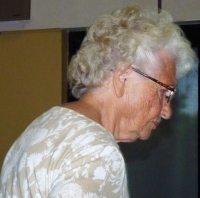 First up was Dorothy Wood (photo, left), an older woman who described living near an excavation project elsewhere, where she contracted Valley Fever from the construction. “It took a long time before I could function again.”
First up was Dorothy Wood (photo, left), an older woman who described living near an excavation project elsewhere, where she contracted Valley Fever from the construction. “It took a long time before I could function again.”
A representative from a trails alliance called for having trails “stay open and unchanged,” noting that many of the 100 equine businesses in the valley back up directly to the mining stie.
One of those business owners, Robin Pawl, owner of The Magic Horse Therapeutic Riding Center, told ECM before the meeting that she and her husband, Larry, moved to this valley in January from elsewhere in Lakeside. The site is right in front of her property. “We were not told. We did not receive any notice that this was happening,” she said. She worries about the disabled children and horses at her center, adding, “It’s not a healthy environment with the noise and the dust.”
A woman named Marie told planners, “I’m just a girl on a horse.” She called the construction project a “destruction project”, drawing cheers and called the developers “arrogant” to suggest that the valley could be dredged down 90 feet and somehow restored. “What about the animals?” she implored, citing migratory animals, birds, and critical species. She voiced concerns over “vegetation, trees to help the environment the air we breathe, the water we drink.”
Jessica Webb brought her young children to the podium. Pointing to her little boy, she noted the developer predicts restoration will be done by around 2035. “That’s the year he would graduate high school. Would you want these kids breathing that every day for 15 years?” The family’s home is 100 feet from the project, she said.
Zach Newland lives on El Monte Road. “I’m so angry now I just don’t know where to start,” he stasted. “We don’t want city water. We like our wells, and our septic. I have five systems. We live in the canyon. This will have a profound effect on our lifestyle…what time do we have left? Will we have to sell?” He also voiced fear that property values will go down, adding concerns echoed by others over Valley Fever and noise from 250 trucks a day.” I don’t want my wife spending six hours a day cleaning up the dust. “ He then warned the developers that tonight’s turnout is just the beginning of the opposition that they will face if they continue to push forward the project.
Leon Thompson, a Lakeside resident, asked how much water it will take to mine the sand and where it would come from. Coalson saids 168 acre feet a year, or enough water for 336 households, would be used. It is unclear if that figure counts water for dust suppression or not. Thompson also noted that Hanson’s pond has algae blooms and that land adjacent to it remains stripped and bare, as photos he provided to ECM make clear.
A spokesperson for the Wells family ranch said they are very concerned with a business based on trail riding. “It isn’t trail riding on a fire road that’s been graded.” She noted that only 75 acres were listed for revegetation. “What happens to the rest?”
Another resident named Eric voiced fear that vibrations from so many trucks would damage properties and roads. He noted that the Dust Bowl was an unexpected consequences of the Depression. “There will be unexpected consequences here,” he predicted, noting that across America, there are “scars all over the land, cleanups that never happened.”
Then he observed, “Money is temporary . Is it worth having to lose something permanent and irreplaceable? Because once we damage this valley, it’s gone.”
 Photo, left: View over El Monte Valley, taken from El Capitan Mountain by Billy Ortiz
Photo, left: View over El Monte Valley, taken from El Capitan Mountain by Billy Ortiz
Cindy Denny is a board member on a Lakeside riding club and is also active with San Diego Trail Riders. “We’re in a drought. Just how much water are you willing to use to make sure we don’t get Valley Fever?” she asked the developer. She also noted that the valley is place used for fundraisers for charities such as the Boys and Girls Clubs.
She also voiced skepticism over the schedule for selling sand and dismay at loss of trails. “There will be a big impact on charities that use the river. What happens if there is another economic downturn? Where does that leave this project and the restoration? By 2035, some of us can be dead.”
Jim Schilling was born here and has served as a retired senior project manager for the Marines, he testified. He called the project “a bunch of garbage” noting that before the lawsuit involving Helix, the permit was issued for golf. “They got caught mining sand. This is all about money,” he concluded. “This is all about turning our resources into somebody else’s profits.”
Bob Fertik noted that there are already some places in San Diego that produce sand, adding, “They look pretty terrible.”
 Billy Ortiz (photo, right) has lived in the valley for 56 years and has spent a lot of time hiking in the riverbed and on mountains towering above the valley. He has documented the rich abundance of wildlife for the Lakeside Historical Society and various media outlets including East County Magazine. He noted that artists like to come to El Monte Valley to paint its beauty.
Billy Ortiz (photo, right) has lived in the valley for 56 years and has spent a lot of time hiking in the riverbed and on mountains towering above the valley. He has documented the rich abundance of wildlife for the Lakeside Historical Society and various media outlets including East County Magazine. He noted that artists like to come to El Monte Valley to paint its beauty.
“I found a gnatcatcher today, and a vireo,” he said, citing examples of two at-risk species. “How can you destroy habitat already there and say you can restore it? That’s a bad idea.” Ortiz started the opposition group to the project on Facebook. View it here.
Gordon Shackelford was the planning group’s chair when the golf course was approved. He said that had a maximum depth of just 12 feet. “Ninety feet is very different. This is an extraction project. In realty the rate of sale of sands depends on economics – and the duration you say,” he told the developer, “historically we have not had.”
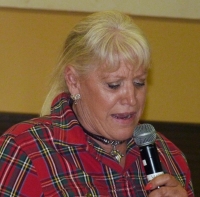 Joan Pillsbury (photo, lefet), known to many as Joan Embery, the San Diego Zoo’s long-time ambassador, spoke next. She voiced anguish over the project. “I don’t want to lose what we have in this valley.” But she also called on residents to sit down with the developers and ask if there is a way to eliminate the worst aspects of the project, keep trails and end up with a nature park. “I beg of all of you,” she said, urging dialogue “if you have ideas on how we can save our valley.”
Joan Pillsbury (photo, lefet), known to many as Joan Embery, the San Diego Zoo’s long-time ambassador, spoke next. She voiced anguish over the project. “I don’t want to lose what we have in this valley.” But she also called on residents to sit down with the developers and ask if there is a way to eliminate the worst aspects of the project, keep trails and end up with a nature park. “I beg of all of you,” she said, urging dialogue “if you have ideas on how we can save our valley.”
The next speaker disagreed with Pillsbury. “I don’t think there can be any concession to sand mining in our valley,” he asserted. He also noted there could be equipment repairs generated noise and lights at night. Moreover, he pointed out, “Supervisors approved by right rock-crushing and concrete making at any extraction site. In all my years in planning, I never saw any go to reclamation. I was on the planning group when the golf course was approved. It seemed like a good use. Sand mining now is completely at odds with what the community approved before.”
After the public comments concluded, with several other speakers waiving their time since their points had been made, planners discussed the project, making clear the developer faces steep opposition here.
Ensal concluded simply, “This is not the right project for Lakeside.”
Allen, who was also on the board when the golf course went through, told the developers, “You can make money – just make something beautiful.”
Montgomery stated, “I want to see somebody else buy the land,” adding that she wants a different use.
Nathan Thompson told the community, “Your show of opposition sends a strong message…I just can’t stand to see this happen in my community.” But he added, “We do need to come to the table” to discuss alternatives.
Cyphert disagreed with Pillsbury’s remarks. “These people bought this speculating they will come in and mine our valley and make all this money. Sometimes when you speculate, you lose!” He noted that under the original Helix plan, the use was approved as a golf course project, “something beautiful, not strip mining.”
Mitten cited concerns over wildlife, health, trucks and loss of entertainment. “This is industrial use...Destroying our valley is not appropriate.”
Anderson noted that “This is private property,” asking, “If we do not approve this, what are you going to approve?”
Sesko said firmly, “There is no possible way I could support sand mining.” He added that he would volunteer his time to meet with the “nature preserve” representatives, noting, “That is an interesting name for sand mining.”
But Sesko cautioned all present, “We are an advisory board.” He urged everyone to contact Supervisor Dianne Jacob. But he pointed out, “The other Supervisors don’t live out here and there is a lot of revenue from sand mining…They may not listen. So we’ve got to reach out further than this board.”
Suppport more in-depth reporting on this important issue and others in your community!
Please donate to our nonprofit award-winning community news outlet at www.eastcountymagazine.org/donate. You can donate via check, credit card or Paypal. Monthly pledges are especially important so we can budget ahead to send reporters to important meetings like this one.








Comments
There's now a petition to Save El Monte Valley here:
http://www.eastcountymagazine.org/petition-save-scenic-el-monte-sand-mining
sand mining
HEAD EAST?
No way. We have had enough destruction benifiting the city dwellers!
El Monte Valley Project
Clarification on El Monte Valley project
Robin Rierdan, Executive Director with the Lakeside River Park Conservancy, asked us to clarify that Michael Beck is no longer associated with their enviornmental organization. Specifically, she wrote: "Michael Beck left our board in 2006. We have a project on the Hanson El Monte Pond that he owns but I would ask you to please not associate our name with his. We do not support his activities."
Long Battle Ahead
One solution to stop communities from being steamrolled
by a majority of Supervisors who don't live in East County ramming through destructive projects like sand mining, industrial scale wind and solar projects would be for all the citizens sick of this to get an initiative on a countywide ballot to change the county charter and declare that Planning Groups cannot be overruled, at least to force through a major project on a goliath scale.
In my personal view these boards should NOT be advisory, and these decisions ought to be made by people who live in these areas and the people they represent -- not officials who don't even live in East County and can't be voted out by those stuck with the consequences of their actions. So often Supervisor Jacob is out-voted 4 to 1. But even her strong voice is not enough to stop projects where there is so much money and power involved and what happens if a future Supervisor is less concerned with voters' lives than corporate donors? Other places in the county are seeing the same thing happen - look at Lilac Ranch in Valley Center and One Paseo in Carmel Valley, projects the people there don't want either. But money and power are doing the talking.
An amendment could also require that if property values go down due to a massive project the people should be compensated just as with freeway projects. That is not being done, and some property owners have had their homes devalued by 40% or more near big energy projects. The sand mining could be even worses. I would also want to see a requirement for any industrial scale energy project to include analysis of non-industrial scale alternatives, ie, if the same subsidies were provided to rooftop solar, mass transit, etc. could the same goal of reducing greenhouse gases be achieved for less money and certainly a lot less disruption and harm to the environment and people's lives?
I would like to convene an Eco-Summit East to educate people across our region on the negative things that are happening with our environment and the land use process, and partner with others who might want to sponsor such an event or a portion of it that might include brainstorming sessions with community and enviornmental leaders on potential real solutions to stop this kind of abuse of East County residents. I for one am sick of seeing the interests of corporations and governments motivated by revenues/greed over what's right for people and the enviornment.
If anyone wants to help financially or serve on a committee to make an Eco-Summit East happen, please email me on my private email at writerink@cox.net.
More Destruction from a season Pro
Not Again!
Another small East County community is being steamrolled to put in an industrial project in a County-designated scenic view corridor and recreation area. The residents liked the old idea a golf course because it was a better fit. What's wrong with that? Why have designations in the first place if they don't mean anything?